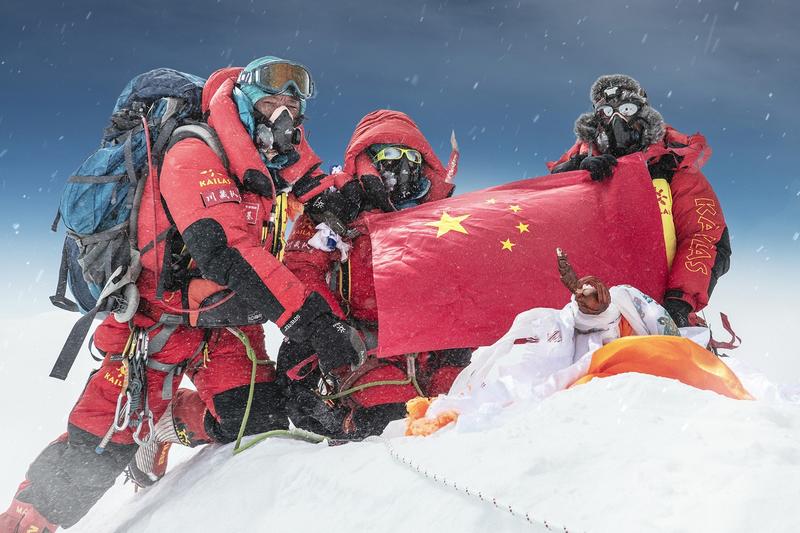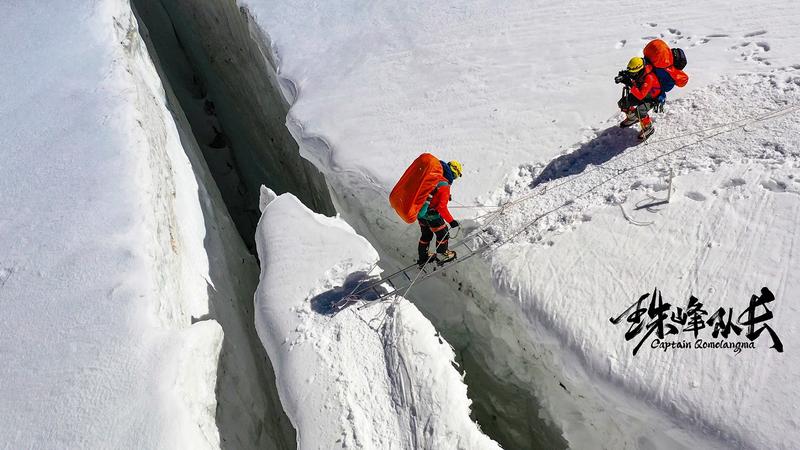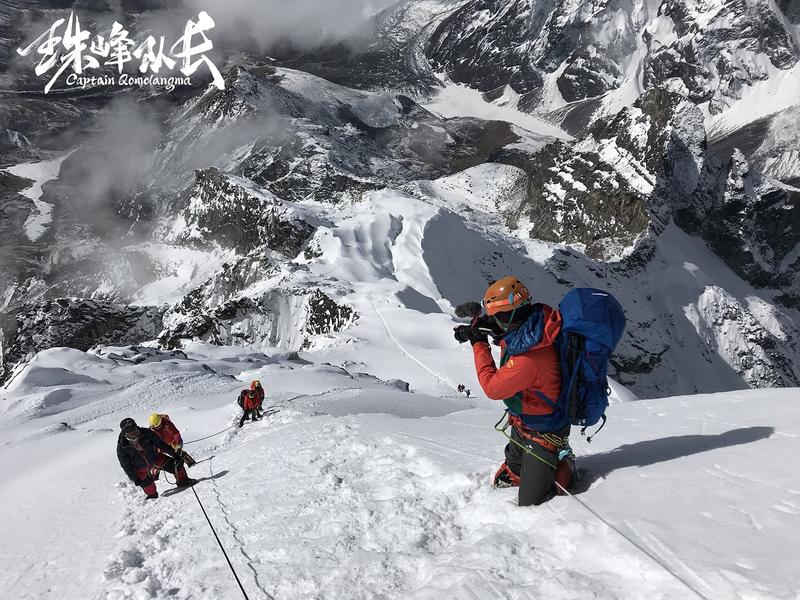Intrepid Tibetan mountaineer from Sichuan province led a team of 14 to film the arduous trek up and down the world's tallest peak in 2019. The drone-aided documentary is now earning rave reviews, report Wang Qian and Wang Kaihao.
 Stills from the documentary Captain Qomolangma show how Sula Wangping, 39, from Aba Tibetan and Qiang autonomous prefecture in Sichuan province, guided a team of eight climbers and six cameramen to the summit of Qomolangma in 2019. (PHOTO PROVIDED TO CHINA DAILY)
Stills from the documentary Captain Qomolangma show how Sula Wangping, 39, from Aba Tibetan and Qiang autonomous prefecture in Sichuan province, guided a team of eight climbers and six cameramen to the summit of Qomolangma in 2019. (PHOTO PROVIDED TO CHINA DAILY)
Its incredible height of 8,848 meters is just one of the many perils that plague the journey to Qomolangma. The weather at high altitude is dynamic and vicious. The very low atmospheric pressure can trigger hypoxemia and cause hallucination. Plenty of crevasses make the Khumbu icefall a death trap. Navigating seracs (fragile glacial ice columns) is like a suicidal mission. The list of challenges is endless.
And yet, according to the US-based Himalayan Database, in its 2021 update, more than 6,000 mountaineers have successfully scaled Qomolangma-known as Mount Everest in the West-since New Zealander Edmund Hillary and his Nepalese guide Tenzing Norgay first reached the summit in 1953.
My eight climbers and six lensmen were just ordinary people who grew up with me. They had followed me to mountains ... and finally, 8,848 meters.
Sula Wangping, a Tibetan mountaineer from Sichuan province
The number of climbers from China who made it to the top is 500.In 2019, Sula Wangping not only became one of them, he also guided a team of eight climbers and six cameramen to the peak, bringing their adventure to the big screen in a breathtaking documentary.
Captain Qomolangma premiered in cinemas on Saturday and earned critical acclaim. "I hope our film allows people to feel the glory of Qomolangma. It is an experience of a lifetime," the 39-year-old climber tells China Daily in an exclusive interview.
"As a documentary on mountaineering, it has the power to educate and influence, bringing Qomolangma and the sport of climbing close to people who are curious about the world's tallest peak," says Sula Wangping, who hails from Aba Tibetan and Qiang autonomous prefecture in Southwest China's Sichuan province.
Captain Qomolangma is a film of many firsts. It recorded the first team in the world that reached the summit in that year, 2019. It is said to be the first domestic documentary made using drones at such a high altitude.
 Stills from the documentary Captain Qomolangma show how Sula Wangping, 39, from Aba Tibetan and Qiang autonomous prefecture in Sichuan province, guided a team of eight climbers and six cameramen to the summit of Qomolangma in 2019. (PHOTO PROVIDED TO CHINA DAILY)
Stills from the documentary Captain Qomolangma show how Sula Wangping, 39, from Aba Tibetan and Qiang autonomous prefecture in Sichuan province, guided a team of eight climbers and six cameramen to the summit of Qomolangma in 2019. (PHOTO PROVIDED TO CHINA DAILY)
Scaling Qomolangma is as much a test of mental strength as it is of physical endurance, which makes documenting the climb "the most difficult and dangerous thing" that Sula Wangping has ever done. A brainchild of the intrepid Tibetan climber, the project cost him nearly 10 years of his life and over 10 million yuan ($1.49 million). To finance the film, he had to mortgage his house. "Looking back, I realize how crazy the whole thing was, but I don't regret it," he says.
A member of the daredevil expedition, 48-year-old Cui Zhouping from Nanjing, East China's Jiangsu province, says it was the sheer willpower of a seasoned climber that saw the film through. "For Sula Wangping, the documentary was like another mountain he needed to climb; a challenge much tougher than Qomolangma itself," Cui adds.
Qin Xiaoyu, the film's producer, says Sula Wangping is the kind of person who can motivate others in the face of adversities. "The documentary is a tribute to one's confidence to overcome hardships. It will resonate with people fighting against the pandemic for more than two years," he said after a prescreening of the documentary in Beijing last month.
Most acclaimed mountaineering documentaries usually end with the climax of successful summiting. "This one traces the journey home too. For ordinary people, climbing Qomolangma may be an impossible dream, but returning home after meeting everyday challenges may strike a chord. And that's what makes the documentary special," Qin adds.
 Stills from the documentary Captain Qomolangma show how Sula Wangping, 39, from Aba Tibetan and Qiang autonomous prefecture in Sichuan province, guided a team of eight climbers and six cameramen to the summit of Qomolangma in 2019. (PHOTO PROVIDED TO CHINA DAILY)
Stills from the documentary Captain Qomolangma show how Sula Wangping, 39, from Aba Tibetan and Qiang autonomous prefecture in Sichuan province, guided a team of eight climbers and six cameramen to the summit of Qomolangma in 2019. (PHOTO PROVIDED TO CHINA DAILY)
From herdsman to climber
Sula Wangping's native village is located at the foot of San'ao Snow Mountain in Sichuan's Heishui county, where people make a living by raising livestock or by digging caterpillar fungus in the mountains.
At the age of 9, he first left home with his father, a civil servant, to study at a primary school in town. After graduating from a vocational school in 2001, he returned to the village and waited for job opportunities. "Becoming a civil servant like him was what my father expected of me, but a mountaineering team changed my life the same year," Sula Wangping says.
The climbers arrived at the village on their way to San'ao Snow Mountain, which comprises three peaks, the main being 5,282 meters above sea level. They hired villagers as porters. He was one of them.
"It was the first time in my life I saw professional climbers. Their entire gear-from sleeping bags and tents to carabiners, harness and ice axe-made me curious. What's more, I realized that there were other ways of making a living in the mountains," he says.
Ma Yihua, a member of the expedition, was impressed by Sula Wangping's amateur climbing skills and later invited him to join a commercial mountaineering company in Chengdu, Sichuan. Sula Wangping packed his belongings and left the village without trepidation. "At that time, all I wanted was a fresh start. I didn't even know being a mountain guide was a profession," he recalls.
After two years of working as a guide, Sula Wangping established a mountaineering firm in October 2003 with six childhood friends. "Compared to townspeople, we Tibetans grow up in the mountains and have a lot of stamina. We also know the mountains better," he says.
Business wasn't great during the first two years. There was a dearth of clients and hence, little money to buy good gear. Families weren't very supportive either. To build a reputation in the mountaineering circuit, Sula Wangping and two of his friends decided to climb the technically demanding Celestial Peak (or Pomiu Peak) along Mount Siguniang in western Sichuan. The peak is a pyramidal granite tower with an altitude of 5,413 meters.
In August 2005, after five days of climbing in rubber shoes instead of mountain boots, the trio reached the top. They never had to look back since. Business became profitable in a matter of weeks and today, after 19 years, the firm boasts 60 professional guides, who all come from Sula Wangping's native village.
"Two decades ago, I wanted to find a way out of a mundane mountain life. After I realized my dream, my next target was to introduce more people from my village to new means of livelihood. Mountaineering has changed our lives," he says.
 Stills from the documentary Captain Qomolangma show how Sula Wangping, 39, from Aba Tibetan and Qiang autonomous prefecture in Sichuan province, guided a team of eight climbers and six cameramen to the summit of Qomolangma in 2019. (PHOTO PROVIDED TO CHINA DAILY)
Stills from the documentary Captain Qomolangma show how Sula Wangping, 39, from Aba Tibetan and Qiang autonomous prefecture in Sichuan province, guided a team of eight climbers and six cameramen to the summit of Qomolangma in 2019. (PHOTO PROVIDED TO CHINA DAILY)
Behind the scenes
Sula Wangping describes himself as "a man of many dreams". As a climber, he pushed boundaries-he not only scaled Qomolangma, but also led a team to document the ascent and descent for posterity.
He began his pet project in 2014, when he handpicked 10 mountain guides and turned them into lensmen. It was impossible to find a professional film crew to go the whole hog and he decided that the guides would do his documentary more justice. They learned how to handle cameras from scratch and went on to master the skill of filming with drones.
Every year after that, Sula Wangping studied the brief window of summit days-usually lasting a week after May 15-when the temperatures are a tad warmer, the weather is stable and there is no wind.
In April 2019, the team of 15 embarked on the incredible Qomolangma journey from the Southeast Ridge via Nepal. "My eight climbers and six lensmen were just ordinary people who grew up with me. They had followed me to mountains at 5,000 to 6,000 meters, then 7,000 meters and finally, 8,848 meters," Sula Wangping says.
Shooting was undoubtedly the toughest part of the arduous climb. "Every cameraman carried equipment weighing about 40 kilograms while a climber usually carried about 10 kg," he recalls.
To protect cameras and drones from freezing, they kept the equipment wrapped close to the body during the day and inside sleeping bags at night. To guarantee that the drones functioned without interruption at high altitude, more than 30 batteries were packed.
On May 15, the team reached the summit, the first to do so in 2019.Eleven people reportedly died on Qomolangma that year, making it the deadliest since 2015.
Sula Wangping strongly contests using the expression "conquering "when referring to summiting a mountain. In his eyes, mountaineering is a process in which people must expect to be accepted by nature. He always led his team to traditional Tibetan blessing ceremonies before setting foot on the mountains.
He clearly knows the dangers of expeditions, which are sometimes fatal. Despite being "a dream chaser", he never forgets his own motto: "Set off only when you know the score".
Sula Wangping's next dream, according to the ambitious man himself, is to complete the Explorers Grand Slam, a challenge to scale the highest peaks in seven continents, and reach the North Pole and the South Pole.
Contact the writers at wangqian@chinadaily.com.cn


